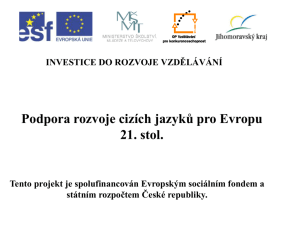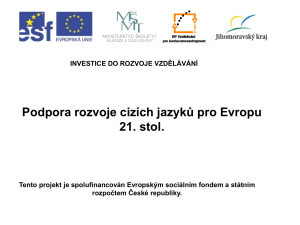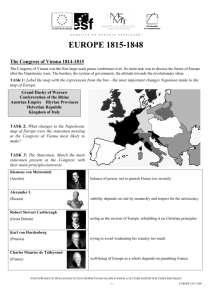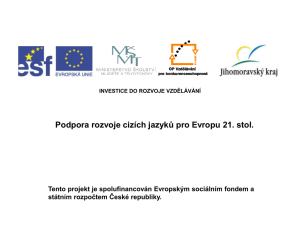ORGANIC CHEMISTRY = chemistry of compounds containing C−H
advertisement
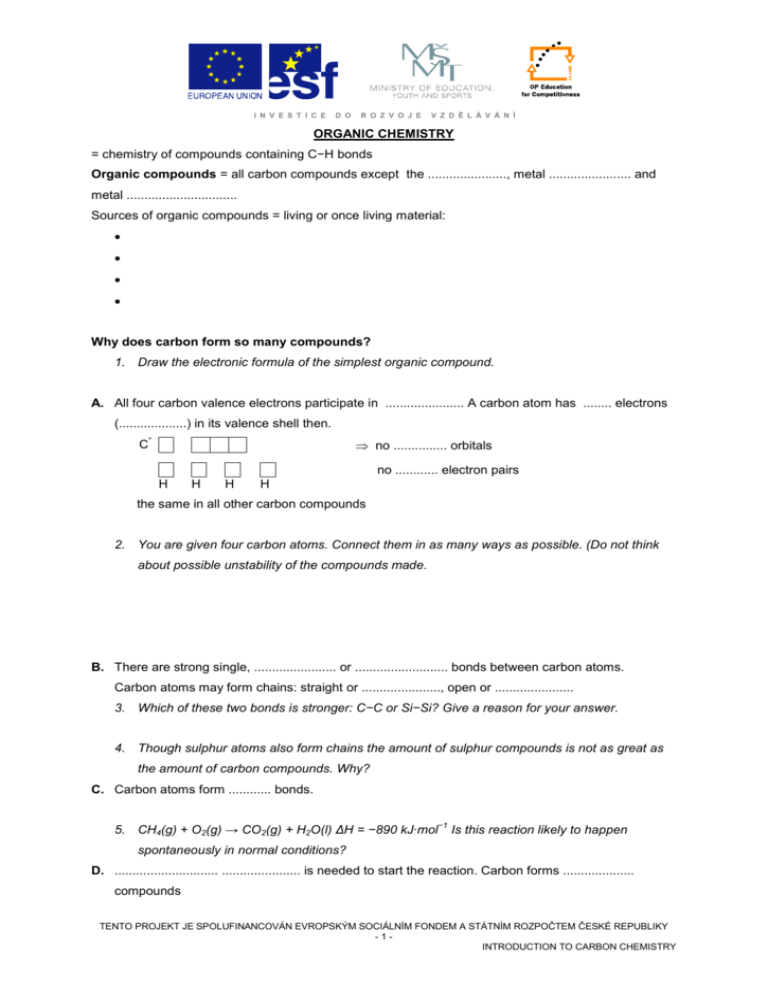
I N V E S T I C E D O R O Z V O J E V Z D Ě L Á V Á N Í ORGANIC CHEMISTRY = chemistry of compounds containing C−H bonds Organic compounds = all carbon compounds except the ......................, metal ....................... and metal ............................... Sources of organic compounds = living or once living material: Why does carbon form so many compounds? 1. Draw the electronic formula of the simplest organic compound. A. All four carbon valence electrons participate in ...................... A carbon atom has ........ electrons (...................) in its valence shell then. C * no ............... orbitals no ............ electron pairs H H H H the same in all other carbon compounds 2. You are given four carbon atoms. Connect them in as many ways as possible. (Do not think about possible unstability of the compounds made. B. There are strong single, ....................... or .......................... bonds between carbon atoms. Carbon atoms may form chains: straight or ......................, open or ...................... 3. Which of these two bonds is stronger: C−C or Si−Si? Give a reason for your answer. 4. Though sulphur atoms also form chains the amount of sulphur compounds is not as great as the amount of carbon compounds. Why? C. Carbon atoms form ............ bonds. −1 5. CH4(g) + O2(g) → CO2(g) + H2O(l) ΔH = −890 kJ∙mol Is this reaction likely to happen spontaneously in normal conditions? D. ............................. ...................... is needed to start the reaction. Carbon forms .................... compounds TENTO PROJEKT JE SPOLUFINANCOVÁN EVROPSKÝM SOCIÁLNÍM FONDEM A STÁTNÍM ROZPOČTEM ČESKÉ REPUBLIKY -1INTRODUCTION TO CARBON CHEMISTRY I N V E S T I C E D O R O Z V O J E V Z D Ě L Á V Á N Í FINDING A FORMULA OF AN ORGANIC COMPOUND 1. Empirical formula = expresses the simplest ratio between bonded atoms Revision: Find an empirical formula of a substance consisting of carbon and hydrogen knowing that: a) w(C) = 75%, w(H) = 25% b) w(C) = 81.82%, w(H) = 18.18% In organic chemistry combustion analysis is used – a sample of organic substance is burnt completely producing CO2 and H2O. CO2 is absorbed in one absorber, water in another one and from the mass differences m(CO2) and m(H2O) may be stated. The empirical formula of this substance is calculated from these data. CxHy + (2x + y/2)/2 O2 → x CO2 + y/2 H2O Worked example: 5.000 g of an unknown organic substance were burnt completely producing 15.278 g of CO2 and 7.500 g of water. Determine its empirical formula. n(C) = n(CO2) = m(CO2) : M(CO2) = ..................... = .............. mol n(H) = ........ × n(H2O) = ........× m(H2O) : M(H2O) = ............................ = .............. mol x : y = n(C) : n(H) = ....................... = ................ = .................. C....H.... To check whether the calculation is correct and that there is no other element in the compound we may calculate the masses of carbon and hydrogen in the compound: m(C) = n(C) × M(C) = .................... = ............. g m(H) = n(H) × M(H) = ...................... = ............... g m(C) + m(H) = ............................... Substance consisting of carbon and hydrogen atoms only = ...................................... 1. A sample of a hydrocarbon is subjected to combustion analysis and it gives 0.360 g of CO2 and 0.196 g of H2O. Determine its empirical formula. 2. (C3H8) 1 g of an unknown organic compound gives on combustion analysis 1.375 g of CO2,1.125 g of water and no other product. Calculate the masses of C and H in the sample and state whether there is some other element in the compound. Calculate its mass and determine the empirical formula of the compound. Suggest the possible structural formula. (CH4O) TENTO PROJEKT JE SPOLUFINANCOVÁN EVROPSKÝM SOCIÁLNÍM FONDEM A STÁTNÍM ROZPOČTEM ČESKÉ REPUBLIKY -2INTRODUCTION TO CARBON CHEMISTRY I N V E S T I C E D O R O Z V O J E V Z D Ě L Á V Á N Í 3. 0.1g of an unknown compound gives on complete combustion 0.06 g of water, 0.147 g of CO2 and no other product. Determine its empirical formula. Suggest two possible molecular formulae and corresponding structural formulae. (CH2O, C2H4O2) 2. Molecular formula = expresses the real number of atoms in the molecule To determine a molecular formula of a compound we must know its relative formula mass. Calculating Mr using the ideal gas equation: pV = nRT pV = (m/M)∙RT M = mRT/pV Using mass spectroscopy 4. Determine the molecular and empirical formulae for: formaldehyde HCHO, ethanoic acid CH3COOH glucose C6H12O6 5. Calculate relative formula masses for all these three compounds and find the relationship between empirical and molecular formulae. Mr(compound) : Mr(empirical formula) = n (whole number) molecular formula = n × empirical formula Worked example: A hydrocarbon has the following composition: w(C) = 85.714%, w(H) = 14.286% and the relative formula mass is 42. Determine its empirical and molecular formula. n(C) : n(H) = .................................. = ........................... = ............ C...H... Mr(comp.) : Mr(emp.form.) = .................. = ........ C....H.... 6. A sample of a hydrocarbon X is subjected to combustion analysis. It produces 1.257 g of CO2 and 0.514 g of water. Use the mass spectrum below to determine its Mr. Find the empirical and the molecular formula. Suggest one possible structural formula (= formula showing the bonds between atoms). (C6H12) TENTO PROJEKT JE SPOLUFINANCOVÁN EVROPSKÝM SOCIÁLNÍM FONDEM A STÁTNÍM ROZPOČTEM ČESKÉ REPUBLIKY -3INTRODUCTION TO CARBON CHEMISTRY I N V E S T I C E D O R O Z V O J E V Z D Ě L Á V Á N Í 7. A hydrocarbon P gives 0.65185 g of CO2 and 0.20000 g of water on complete combustion. Mr(P) = 54. Find the molecular formula of this compound and suggest one structural formula. (C4H6) 8. 0.1 grams of an unknown substance are completely burnt producing 0.33 g of CO2 and 0.09 g of H2O and no other products. Is this substance a hydrocarbon? What is the molecular formula of this substance knowing that it is a gas and that 0.1 g of this substance occupies the volume 3 of 0.056 dm at s.t.p.? 9. (C3H4) 0.1 g of an unknown substance containing carbon and hydrogen is subjected to combustion 3 analysis producing 0.0723 dm (at s.t.p.) of carbon dioxide and 0.087 g of water and no other product. Is this substance a hydrocarbon? Find the molecular formula of this substance knowing its Mr = 62 (C2H6O2) 10. 0.5 g of an organic substance D are completely burnt and it produces 1.1 g of CO2, 0.6 g of water and no other product. Calculate its molecular formula. Mr(D) = 60 (C3H8O) 3. Rational formula – shows characteristic groups Characteristic group = atom or a groups of atoms bonded to a hydrocarbon skeleton, e.g. halogens (F, Cl, Br, I), hydroxy group (OH), carbonyl group (C=O),... Homologous series = a series of substances with the same characteristic group, their members differ by −CH2−. The members of the same homologous series have the same or similar properties. ISOMERISM = molecules have the same …………………….…. formula but their atoms are arranged in a different way. Types of isomerism: 1. Structural (constitutional) isomerism Structural isomers have the same molecular but different ........................ formula. a. Chain (skeletal) isomerism: isomers differ in the arrangement of carbon atoms 1. How many isomers are there of molecular formula: a. C4H10 c. C6H14 b. C5H12 d. C7H16? TENTO PROJEKT JE SPOLUFINANCOVÁN EVROPSKÝM SOCIÁLNÍM FONDEM A STÁTNÍM ROZPOČTEM ČESKÉ REPUBLIKY -4INTRODUCTION TO CARBON CHEMISTRY I N V E S T I C E D O R O Z V O J E V Z D Ě L Á V Á N Í b. Position isomerism: isomers differ in the position of the functional group 2. Write down all the structures with the molecular formula: a. C3H7Cl b. C3H6Cl2 3. Write down all the structures with the molecular formulaC4H8Br2 and state what kind of isomerism is involved. c. Functional group isomerism: two substances with the same molecular formula possess a different functional group, they are members of different homologous series 4. Find two functional group isomers with the molecular formula C2H6O. 5. Find all isomers with the molecular formula a. C3H8O b. C5H10 and state what kind of isomerism is involved 2. Stereoisomerism Stereoisomers have the same structural formulae but they differ in the arrangement of atoms in 3D space. a. Geometric isomerism (Z (cis), E (trans) isomerism): typical for alkenes and their derivatives. 6. Predict the shape of the molecule of ethene (CH2=CH2). 7. Draw two possible 3D arrangements of CHCl=CHCl knowing that there is no possible rotation around the double bond. 8. Which of the following molecules can show geometric isomerism. Draw their arrangements a. (CH3)2C=CH2 b. CH3CH=CHCH3 c. CH3CH=CH2 d. (CH3)2C=C(CH3)2 e. CH3CH2CH=C(CH3)CH2CH3 b. Optical isomerism When a substance contains a carbon atom with four different groups attached, these groups may be arranged in 3D space in two different ways. TENTO PROJEKT JE SPOLUFINANCOVÁN EVROPSKÝM SOCIÁLNÍM FONDEM A STÁTNÍM ROZPOČTEM ČESKÉ REPUBLIKY -5INTRODUCTION TO CARBON CHEMISTRY I N V E S T I C E D O R O Z V O J E V Z D Ě L Á V Á N Í C C This carbon atom is a centre of asymmetry of the molecule and it is called asymmetrical or .................... carbon. The two isomeric structures are called ............................ They are mirror images of one another. They are often labelled by letters L and D (according to Lglyceraldehyde and D-glyceraldehyde) Special property of optical isomers = optical activity , i.e. ability to rotate the plane of plane polarised light. Plane polarised light = light vibrating in a single plane perpendicular to the direction of propagation. A solution of an optically active compound The two enantiomers with the same structural formula differ in the direction they rotate the plane. Their solution containing the same number of moles of both enantiomers is called ................................ mixture. 9. What happens to a plane polarised light passing through the racemic mixture? Most naturally occurring optically active compounds occur as one isomer only: D-sugars, L- aminoacids. 10. The picture below shows D-glyceraldehyde. Draw the shape of L-glyceraldehyde. H C HO CH 2OH CHO TENTO PROJEKT JE SPOLUFINANCOVÁN EVROPSKÝM SOCIÁLNÍM FONDEM A STÁTNÍM ROZPOČTEM ČESKÉ REPUBLIKY -6INTRODUCTION TO CARBON CHEMISTRY I N V E S T I C E D O R O Z V O J E V Z D Ě L Á V Á N Í 11. Does CHClBrF show optical isomerism? If yes, draw the 3D configuration of both enantiomers. 12. Draw the structure of the simplest alkane that shows optical activity. 13. Find a substance in the question 2 that shows optical isomerism 14. Which of the following formulae A-L show the same compounds? 15. Which of the compounds are chain isomers? H H H H H H H C C C C C C H H H H H H H H H H H C C C H H HC H H C C H H H B CH3 H2C H3C CH H A H CH2 C H3C (CH3)2CHCH2CH2CH3 D HC H F G H H H H C C C C H H H H H C H I H C H H CH3 H H H H C C C H H H H HC H H C H H C H H H3C CH3 CH H3C CH2 K (CH3)2CHCH2CH3 L REACTION MECHANISMS IN ORGANIC CHEMISTRY Reaction mechanism = a sequence of steps the reaction goes in Types of reactions: Substitution = one atom or a group of atoms is replaced (substituted) by another CH4 + Cl2 → CH3Cl + ......... Addition = two substances react together to form one substance. Addition usually requires the presence of a double or a triple bond H H C=C H H E CH3 CH3 CH3(CH2)4CH3 CH2 + HBr → ....................... TENTO PROJEKT JE SPOLUFINANCOVÁN EVROPSKÝM SOCIÁLNÍM FONDEM A STÁTNÍM ROZPOČTEM ČESKÉ REPUBLIKY -7INTRODUCTION TO CARBON CHEMISTRY J I N V E S T I C E D O R O Z V O J E V Z D Ě L Á V Á N Í Elimination = a small molecule is removed (eliminated) from a larger molecule. This usually leads to the formation of a ...................... or ....................... bond. H H H – C – C – H → H2 O + .......................... H OH Rearrangement = bonds between atoms within one molecule are changed 1. Classify the following reactions as substitution, addition, elimination or rearrangement a. CH3CH=CH2 + Br2 → CH3CHBr−CH2Br b. C6H6 + Br2 → C6H5Br + HBr c. CH3CH2C(CH3)2Cl → HCl + CH3CH=C(CH3)2 d. CH2=CHOH → CH3CHO e. CH3I + NaOH → CH3OH + NaI Ways of breaking bonds (bond fission) Covalent bond: two electrons are ........................ by two atoms Homolytic fission: electrons are shared almost equally by two atoms. When the bond is broken, each atom takes .......... electron. The atoms formed are highly reactive, they are called ........................ H−CH3 → H∙ + ∙CH3 ∙CH3 = methyl radical Heterolytic fission: both electrons go to one atom (the one with the lower/higher electronegativity) → ......... are formed. H3C−Br → H3C .... + ......... CH3 .... = carbanion/carbocation .... CH3 = carbanion/carbocation Carbocations are attracted to groups with ........................electric charge, they are called ...................... Carbanions are attracted to groups with ........................electric charge, they are called ......................... Electrophiles are attracted to groups which can donate/accept electrons. Nucleophiles are attracted to groups which can donate/accept electrons. 2. Classify each of the groups below as carbocation, carbanion, free radical or none of these: a. C3H7∙ − b. Cl c. − + C2H5 e. CH3CH2 d. Br∙ f. CH3 + 3. Which of the following groups or ions may act as electrophile, nucleophile or both of these: a. HBr b. OH − c. + NO2 d. NH3 e. CN f. H − + TENTO PROJEKT JE SPOLUFINANCOVÁN EVROPSKÝM SOCIÁLNÍM FONDEM A STÁTNÍM ROZPOČTEM ČESKÉ REPUBLIKY -8INTRODUCTION TO CARBON CHEMISTRY
